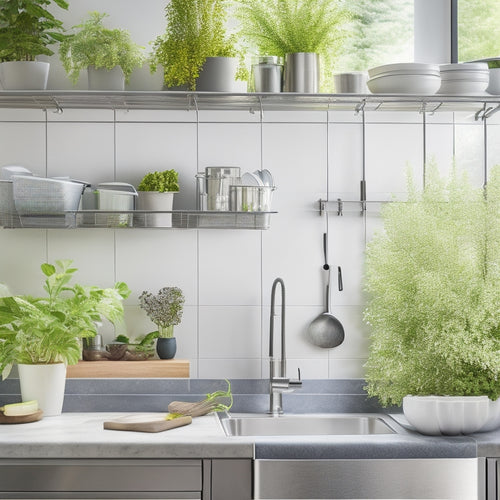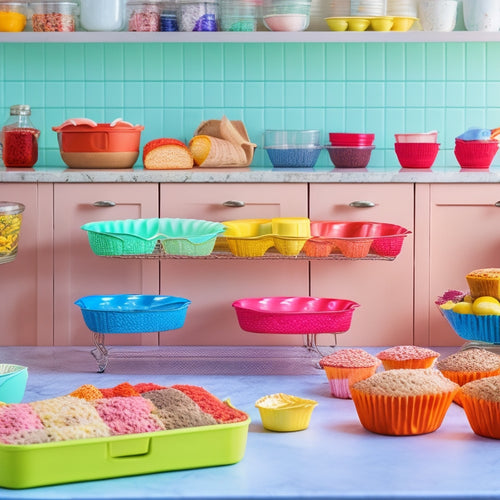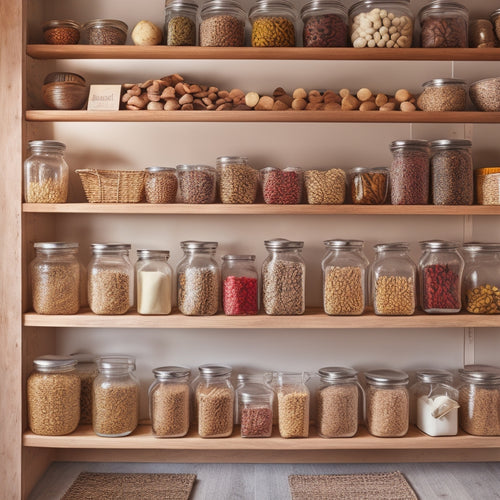
Gluten-Free Kitchen Essentials for Easy Meal Prep
Share
You're about to transform your kitchen into a gluten-free haven, equipped with the essential tools and strategies needed to simplify meal prep and reduce the risk of cross-contamination. Start by maximizing vertical storage space with shelf dividers, stackable containers, and optimized shelf and cabinet space. Implement a labeling system with a hierarchy, color coding, and concise labels to reduce errors. Designate dedicated gluten-free zones, obtain certification, and separate utensils and cooking surfaces to prevent cross-contamination. Next, organize your cabinets and countertops to optimize workflow, and you'll be well on your way to a stress-free meal prep experience; now, take the next step to customize your gluten-free kitchen.
Key Takeaways
• Optimize vertical storage space with shelf dividers, stackable containers, and labels to categorize gluten-free ingredients and equipment.
• Designate dedicated gluten-free zones to prevent cross-contamination, using separate utensils, cutting boards, and cooking surfaces.
• Implement a label hierarchy with color coding and concise labels to quickly identify ingredients and equipment.
• Utilize smart cabinet organization with adjustable shelves, pull-out drawers, and labels to ensure easy access to gluten-free essentials.
• Create an efficient countertop layout by positioning frequently used appliances and ingredients strategically to minimize walking distances and clutter.
Maximizing Vertical Storage Space
To optimize your gluten-free kitchen, start by capitalizing on the often-underutilized vertical storage space, where every inch counts in keeping your gluten-free essentials within easy reach. By doing so, you'll create a more efficient and organized cooking environment that makes meal prep a breeze.
You can achieve this by installing shelf dividers to separate and categorize your gluten-free ingredients, cookbooks, and equipment. This will prevent clutter from building up and make it easier to find what you need when you need it.
Additionally, consider investing in stackable containers that can be labeled and stored on shelves or in cabinets. These containers will help keep your gluten-free staples fresh and organized, while also keeping them out of the way.
Labeling and Signage Strategies
By categorizing and storing your gluten-free ingredients and equipment, you've set the stage for a clutter-free kitchen; now, labeling and signage strategies will help you quickly identify what's inside those containers and shelves.
To take your organization to the next level, implement a label hierarchy that distinguishes between categories, such as 'Grains,' 'Pantry,' and 'Baking Supplies.' Within each category, use color coding to further differentiate between subcategories, like 'Rice' or 'Quinoa' under 'Grains.' This visual system will save you time and reduce errors when preparing meals.
When designing your labels, keep them concise and easy to read. Use a clear, bold font and consider adding icons or images to help you quickly identify the contents. You can also include important details like expiration dates, storage instructions, or recipe suggestions.
Dedicated Gluten-Free Zones
Designate specific areas in your kitchen as dedicated gluten-free zones to prevent cross-contamination and maintain the integrity of your gluten-free ingredients and meals. This is essential, as cross-contamination risks can be high, especially when handling gluten-containing products alongside gluten-free ones. By designating separate zones, you can greatly reduce the risk of contamination and guarantee the safety of your gluten-free meals.
When setting up your dedicated gluten-free zones, consider obtaining gluten-free certification for your kitchen or specific equipment. This certification guarantees that your kitchen or equipment meets strict gluten-free standards, providing assurance for those with gluten intolerance or sensitivity.
In your dedicated zones, use separate utensils, cutting boards, and cooking surfaces to prevent cross-contamination. Store gluten-free ingredients and prepared meals in designated areas, away from gluten-containing products.
Smart Cabinet Organization
You'll maximize your gluten-free kitchen's efficiency by implementing a smart cabinet organization system that keeps essential ingredients and cookware within easy reach. This means you'll spend less time searching for what you need and more time preparing delicious meals for yourself and others.
When selecting cabinets, look for flexibility features that allow you to customize the layout to fit your specific needs. Adjustable shelves, for instance, can be tailored to accommodate different-sized containers and cookware, ensuring everything has a designated place.
Consider installing pull-out drawers or baskets to store heavy items, like pots and pans, making them easier to access. Label each shelf and compartment so you can quickly identify what's inside.
Efficient Countertop Layout
Efficient Countertop Layout
Across your countertops, strategically position frequently used appliances, utensils, and ingredients to minimize walking distances and maximize workflow, ensuring a seamless cooking experience. By optimizing your countertop layout, you'll reduce Countertop Clutter and increase Workflow Optimization, making meal prep a breeze.
| Zone | Essential Items |
|---|---|
| Baking Zone | Stand mixer, baking sheets, measuring cups |
| Cooking Zone | Cooktop, utensil holder, olive oil |
| Prep Zone | Cutting board, knives, colander |
| Storage Zone | Gluten-free pantry staples, spices, cooking references |
Frequently Asked Questions
What Are Some Gluten-Free Alternatives to Traditional Pantry Staples?
You'll swap traditional pantry staples for gluten-free alternatives like almond flour, coconut flour, or rice flour options, and pasta substitutes like zucchini noodles, spiralized veggies, or quinoa-based noodles for a guilt-free meal prep.
Can I Use the Same Cooking Utensils for Gluten-Free and Gluten-Containing Foods?
'When cooking for others, you'll want to separate shared spaces to avoid cross-contamination. You're wise to wonder if you can reuse utensils; the answer is no - use separate tools to maintain gluten-free integrity and safeguard your guests' health.'
How Do I Prevent Cross-Contamination With Gluten in the Kitchen?
To prevent cross-contamination with gluten in your kitchen, you'll want to establish designated zones for gluten-free and gluten-containing foods, and maintain a strict cleaning schedule to avoid accidental exposure.
Are All Gluten-Free Products Automatically Healthier Than Their Gluten-Containing Counterparts?
You think swapping gluten-containing products for gluten-free ones is a health win, but beware: many gluten-free products are highly processed and packed with added sugars, making them nutritionally inferior - don't fall for label traps and nutrition myths.
Can I Convert My Favorite Recipes to Gluten-Free Versions Easily?
You can easily convert your favorite recipes to gluten-free versions by making strategic recipe swaps, such as substituting flours and starches, to maintain original flavor profiles, ensuring your dishes remain delicious and satisfying for those with dietary needs.
Related Posts
-

Wall-Mounted Dish Drainer Racks for Kitchens
Wall-mounted dish drainer racks are a game changer for your kitchen. They maximize vertical space, freeing up preciou...
-

Roll-Out Trays for Organizing Baking Supplies
Roll-out trays are perfect for organizing your baking supplies, making your kitchen more efficient. They maximize spa...
-

Innovative Pantry Storage Ideas for Homes
Revamp your pantry into an efficient space with innovative storage solutions. Use vertical storage options like ceili...


